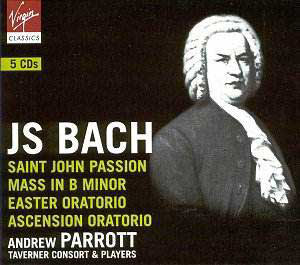Andrew Parrott’s recordings of Bach’s sacred music
are an acquired taste. His approach is at one extreme in the wide range
of ways to interpret and record these works. Parrott is one of the leading
proponents of the one-voice-per-part (OVPP) style, which states that
Bach had no access to the kind of huge choirs we now often hear performing
these works, and settled for one, or, at best, two singers for each
of the parts in the choir (soprano, alto, tenor, bass). While many conductors
and performers are totally against this approach, first posited in the
1980s by Jeremy Rifkin, Parrott has shown, in his recordings, that it
is not only feasible, but that it can be musically satisfying, if listeners
can only rid themselves of preconceptions and habits as to how they
feel the music can be performed and heard.
It must be said that this approach is mainly apparent
in the choral movements of these works. Take the opening Kyrie eleison
of the B Minor Mass, for example. The lightness and ethereal quality
of the music takes on a new dimension. Gone are the dense, heavy choirs
of the more "classical" performances of Bach’s choral music.
Here the choir is present in subtle strokes, and does not overwhelm
the music. Of course, for one familiar with this music, hearing Parrott’s
rendition for the first time, this can be a shock. But the beautiful
texture that is apparent in this music - take the et in terra pax,
for example, where one can hear the subtle interplay of the various
parts - makes it all worthwhile. The listener can imagine being transported
to a different world, when the music was meant to fill a church, and
not a huge concert hall.
The intensity of the opening choral movement of the
St John Passion, or of the penultimate movement of the same work,
does not suffer greatly from the smaller forces. What is lost in quantity
is gained in the magnificent texture. Since there is a fine balance
between the smaller vocal forces and the instrumental forces, the works
sound like "chamber" versions of what most listeners know
as massive choral works.
It should be noted that while Parrott’s and Rifkin’s
ideas have not been embraced widely among performers of Bach, they have
greatly influenced current performance practice. Masaaki Suzuki’s recordings
of Bach’s cantatas are not OVPP, yet the forces engaged remain very
limited; and Paul McCreesh has been performing the St. Matthew Passion
with very small forces (two small choirs, each of eight singers) and
is to record the work in 2003.
Unlike Rifkin, whose OVPP recordings, made in the 1980s
to show the viability of his theories, suffered from soloists of limited
quality, Parrott has some of the finest singers possible for these works.
To note just a few, Emma Kirkby and Evelyn Tubb are excellent in the
Ascension Oratorio, bass Peter Kooy, who has recorded many of Bach’s
cantatas with Masaaki Suzuki, stands out in the Easter Oratorio, and
Rogers Covey-Crump is a brilliant evangelist in the St. John Passion.
The singers’ voices seem to have been chosen to work together at a much
different level than usual, and the combinations in all these works
are very satisfying.
The recordings are quite good, though not outstanding;
one cannot often hear the harpsichord, even in the smaller movements,
but aside from that the recordings work well with the scale of the works.
One adverse criticism for Virgin - the notes with this set are quite
minimal, and give no context to Parrott’s performance practice. Listeners
discovering this music without an understanding of why he chooses such
small forces might be a bit taken aback. But Andrew Parrott recently
wrote a book, The Essential Bach Choir, which gives a clear presentation
of this approach and evidence to defend it.
While a bit unorthodox, Andrew Parrott is certainly
one of the essential figures in recordings of Bach’s sacred music. This
budget set is a must-have set for anyone curious to hear Bach in a different
light, and contains some of the most interesting recordings available
of these great works.
Kirk McElhearn


